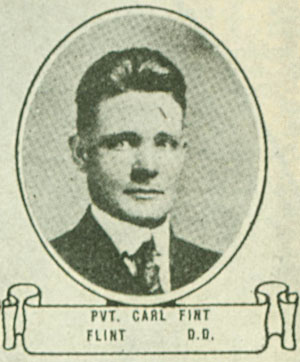

Remember...
Carl Joseph Fint
1895-1918
"Perhaps the summer woods will shimmer bright,
And crimson roses once again be fair,
And autumn harvest fields a rich delight,
Although You are not there."
Vera Brittain
Carl Joseph Fint was one of four children born to John Henry Fint and Mary Alice Elza Fint. John and Mary Alice were married in Randolph County, West Virginia, at the home of the bride on April 3, 1892. To this marriage were born two daughters and two sons. They were: Essie Evelyn, Carl Joseph, Lida Grace (Mrs. Michael H. Cassidy), and Owen Wordsworth.
Carl was born on May 2, 1895, at Rich Mountain in Randolph County. In 1910 the family was living in Nassau County, Florida; the U.S. Federal Census of that year indicates he was a foreman at a sawmill in that area. However, by the outbreak of World War I, the family had relocated back to West Virginia.

Draft registration for Carl Fint. National Archives and Records Administration
On June 5, 1917, when he registered for the initial World War I draft, Carl was living at Flint in Randolph County and was doing sawmill work for his father. At that time he stated that he was single and claimed no exemptions from the draft. His registration describes him as being of medium build and medium height with light blue eyes and brown hair.
Private Carl Fint was assigned to serve in Company A of the 112th Engineers Troop, known as the "Cleveland Grays," which was activated on August 5, 1917.
Just how Carl became a member of the Cleveland Grays is not known, but that organization has itself a rich and interesting history. Founded in 1837 as a private (volunteer) militia due to the decline of politicians' interest in maintaining a constitutionally mandated, state-supported military force, the Grays saw service throughout a number of conflicts, from the Civil War through World War I and beyond. Due to the deterioration of the state militia system, at the onset of the Civil War the Ohio governor quickly called up some ready-to-be-deployed units such as the Grays, which became one of the first two Ohio infantry regiments organized for the war. Reactivated during the Spanish-American War (although they never saw combat), the Grays became the nucleus of several companies of the 1st Battalion of the Ohio National Guard. Indeed, the unit had a somewhat symbiotic relationship with the Guard, slipping in and out of its ranks as either individuals or as a group. During the Mexican Expedition of 1916, they enlisted in the Guard as private citizens, not as a unit, but immediately after they saw service in World War I as the nucleus of the 148th Ohio Volunteer Infantry. (Source: Ohio History Central, "Cleveland Grays," accessed 4 May 2015, http://www.ohiohistorycentral.org/w/Cleveland_Grays?rec=865) The U.S. Army Center of Military History provides the following summary of the Grays' World War I involvement: They were mustered into Federal service 19 June 1916 at Camp Willis, Ohio; expanded, reorganized, and redesignated 24 April 1917 as the 1st Engineer Regiment; drafted into Federal service 5 August 1917; reorganized and redesignated 15 September 1917 as the 112th Engineer Regiment; and demobilized 17 April 1919 at Camp Sherman, Ohio. While the previously mentioned source states that World War I was the last conflict in which the Unit saw active service, the U.S. Army Center of Military History notes that the 112 Engineer Battalion reorganized and redesignated 1 June 1942 as the 112th Engineer Combat Regiment. (Source: Department of the Army, "Lineage and Honors: 112th Engineer Battalion [Cleveland Grays]," accessed 6 May 2015, http://www.history.army.mil/html/forcestruc/lineages/branches/eng/0112enbn.htm) When not participating in armed conflicts, the Grays remained active as a social, educational, and philanthropic organization. The organization maintains a historical presence in Cleveland.
On September 15, 1917, the 112th Engineers Troop was redesignated as the 112th Engineer Regiment and assigned to the 37th Division. Commencing on September 26, 1918, and lasting until the armistice was signed on November 11, the 37th Division was engaged in combat in the Battle of Meuse-Argonne in the Argonne Forest of northeastern France. The objective was to repel the Germans eastward from the Hindenburg Line in order to deny them access to important rail lines that were supplying the German front. During the six weeks' confrontation, 27,277 Americans were killed and 95,786 were wounded.
Carl Joseph Fint died of pneumonia on October 31, 1918, at Staden, a small village in the West Flanders area of Belgium. His death probably was caused by a mustard gas attack by the Germans during the Meuse-Argonne Offensive. Fatalities from exposure to mustard gas primarily resulted from secondary broncho-pneumonia. Fatally injured victims sometimes took four or five weeks to die of mustard gas exposure. U.S. forces suffered 1,462 fatalities from gas warfare.
Some World War I troops were buried several times:first in battlefield graves, then in U.S. cemeteries in Europe, and finally in the United States. At the conclusion of the war, France resisted removing bodies for reburial, but in 1920 the French agreed to the return of American soldiers to the United States. The remains of 46,000 war dead were returned to the U.S. at a cost of over $30 million.
Article prepared by Leon Armentrout, with editorial assistance from Patricia Richards McClure.
April 2015

West Virginia Archives and History welcomes any additional information that can be provided about these veterans, including photographs, family names, letters and other relevant personal history.